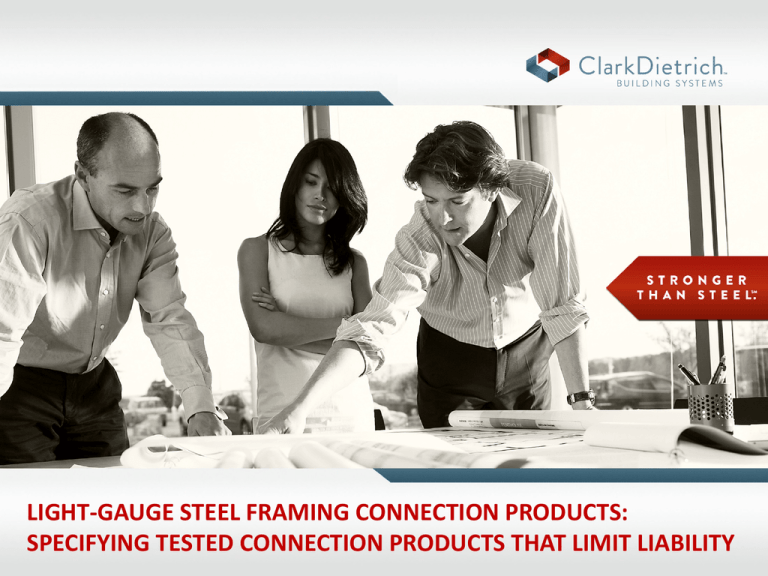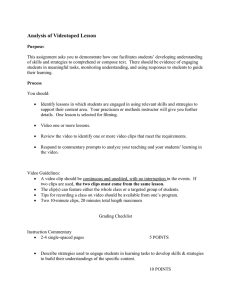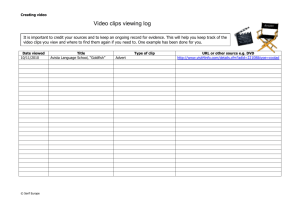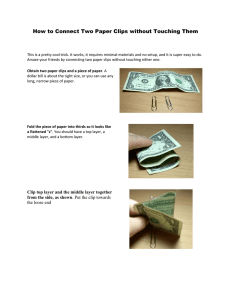light-gauge steel framing connection products
advertisement

LIGHT-GAUGE STEEL FRAMING CONNECTION PRODUCTS: SPECIFYING TESTED CONNECTION PRODUCTS THAT LIMIT LIABILITY LIGHT-GAUGE STEEL FRAMING CONNECTION PRODUCTS: SPECIFYING TESTED CONNECTION PRODUCTS THAT LIMIT LIABILITY LIGHT-GAUGE STEEL FRAMING CONNECTION PRODUCTS: LIGHT-GAUGE STEEL FRAMING SPECIFYING TESTED CONNECTION PRODUCTS: CONNECTION PRODUCTS THAT SPECIFYING TESTED LIMIT LIABILITY CONNECTION PRODUCTS THAT An AIA Continuing Education Program Credit for this course is 1 AIA/CES Learning Unit for HSW credit. LIMIT LIABILITY Course Number: DIE05F This Course is Sponsored By: 9100 Centre Pointe Blvd, Suite 210 West Chester, OH 43069 Tel: (513) 870-1100 Fax: (513) 870-1300 Email: info@clarkdietrich.com Web: www.clarkdietrich.com An American Institute of Architects (AIA) Continuing Education Program Approved Promotional Statement: • Ron Blank & Associates is a registered provider with The American Institute of Architects Continuing Education Systems. Credit earned upon completion of this program will be reported to CES Records for AIA members. Certificates of Completion are available for all course participants upon completion of the course conclusion quiz with +80%. • This program is registered with the AIA/CES for continuing professional education. As such, it does not include content that may be deemed or construed to be an approval or endorsement by the AIA Ron Blank & Associates, Inc. of any material of construction or any method or manner of handling, using, distributing, or dealing in any material or product. An American Institute of Architects (AIA) Continuing Education Program Course Format: This is a structured, web-based, self study course with a final exam. Course Credit: 1 AIA Health Safety & Welfare (HSW) CE Hour. Completion Certificate: A confirmation is sent to you by email or you can print one upon successful completion of course or from your ronblank.com transcript. If you have difficulties printing or receiving your certificate please send requests to certificate@ronblank.com Design professionals, please remember to print your certificate of completion after successfully completing a course conclusion quiz. Email confirmations will be sent to the e-mail address you have provided in your ronblank.com account. COURSE DESCRIPTION Define the use of light-gauge steel framing connection products. Discuss practical applications of deflection clips, support clips and the various methods of installation for different types of connectors. LEARNING OBJECTIVES At the conclusion of this course you should have a better understanding of the following: • Explain how deflection clips are used to attach exterior curtain wall studs to a building structure • Explain how to provide allowance for vertical building movement independent of the cold-formed steel framing • Define what types of support clips are used for rigid or positive attachment connections • Explain the various methods used to install different types of connectors • Properly interpreting the allowable load tables for clips CONNECTION PRODUCT CATEGORIES • Section 1: • Section 2: • Section 3: • Section 4: Deflection Products Rigid Connections Miscellaneous Connectors Load Tables SECTION1:1:DEFLECTION DEFLECTIONPRODUCTS SECTION PRODUCTS • Extended Reach Style Curtain Wall Connector • Surface Mounted Deflection Clip • Offset Bypass Vertical Slide Clip • In-Plane Style Head-of-Wall Clip DEFLECTION CONNECTIONS DFLECTION CONNECTIONS Extended Reach Style Curtain Wall Connector Surface Mounted Deflection Clip Extended Surface Mounted Deflection Clip Offset Bypass Vertical Slide Clip In-Plane Style Head-of-Wall Clip EXTENDED REACH STYLE CURTAIN WALL CONNECTOR An extended reach style curtain wall connector is used to attach a vertical stud to a structural steel spandrel beam (or other support) when there is no provision to attach to the edge of the slab. This system is used to connect by-pass style curtainwall assemblies as shown. Allows for up to 2-1/2” vertical deflection. EXTENDED REACH STYLE CURTAIN WALL CONNECTOR • The connector must engage the building structure a minimum of 4” • Studs are plumbed and then the clip is secured to the studs with proprietary shoulder screws • Embossed with fastening patterns to ensure accurate placement of fasteners • Connectors are manufactured with G90 50 ksi steel. SURFACE MOUNTED DEFLECTION CLIP Surface mounted deflection clips are used to attach exterior curtain-wall studs to the building structure and provide up to 3 inches of vertical building movement independent of the cold-formed steel framing. A surface mounted deflection clip installs quickly with screws or powder-actuated fasteners, and provides adjustable standoff to ensure a plumb wall plane. Proprietary screws ensure friction-free sliding. Each clip is also embossed with fastening patterns to ensure accurate placement of fasteners. OFFSET BYPASS VERTICAL SLIDE CLIPS Offset bypass vertical slide clips are used to attach exterior curtain wall studs (3-5/8” - 8” widths) to the building structure and provide for vertical building movement independent of the cold-formed steel framing. This clip provides variable standoff and eliminates the need for shims or additional framing components. The offset bypass vertical slide clip fastens to the floor/ceiling beam and is secured to the stud with proprietary screws. The clip restricts lateral movement, but enables the building structure to move vertically. Attachment to bottom of beam IN-PLANE STYLE HEAD-OF-WALL CLIP In-plane style head-of-wall clips are used in HOW deflection conditions for in-fill curtainwall assemblies to provide for vertical movement. These clips are used in place of deflection track. They provide a positive attachment and do not require bridging installed continuously throughout.t Clips can be attached to the underside of structural members, concrete decks or floor assemblies. Studs must be cut less than full height to enable vertical movement up to 2-1/2“. he upper. IN-PLANE STYLE HEAD-OF-WALL CLIP The in-plane style head-of-wall clip is attached to the structure by welding or using PAFs or screws and to the top of the stud web using specially designed screws. It is manufactured with G90 50 KSI steel. SECTION 2: RIGID CONNECTIONS • • • • Framing Clips Support Clips Bridging Clips Foundation Connectors RIGID CONNECTIONS RIGID CONNECTIONS Support Clip Framing Clip Bridging Clip Header Hanger Support Clip Framing Clip Clip Angle Anchor Clip Holdown FRAMING CLIP F1 = Shear F2 = Tension F3 = Compression The framing clip can be used to affix the stud to a ledger or directly to red iron. FRAMING CLIP • Framing Clips are used to secure framing members to the building • This clip has an offset leg allowing greater versatility • Framing clips do not allow for deflection SUPPORT CLIP Support clips are used in multiple construction projects, specifically in conjunction with structural studs and track. The L-shaped clips fit between the stud flanges, so that shorter length clips do not need to be ordered. These labor time-savers include prepunched holes for quicker screw attachments, and are punched to accommodate for CRC lateral bracing connections. SUPPORT CLIPS *Note: When not filling all holes, install fasteners symmetrically starting at the top and bottom edges, and moving towards the center of the clip. BRIDGING CLIP Bridging clip is used to secure U-Channel or Cold Rolled Channel (CRC) to structural wall studs when used in loadbearing or curtain wall applications. The wall stud friction fit design allows for as little as one screw for the connection to the U-Channel. The bridging clip is a stiffened, G90 galvanized steel clip that's tested and designed to facilitate the rapid, efficient installation of 1-1/2" U-Channel lateral bracing for exterior curtain wall framing, loadbearing walls or high interior partitions constructed of structural studs. BRIDGING CLIPS • Each end of lateral bracing must be rigidly fixed or otherwise prevented from horizontal movement HOLDOWN Shearwall Attachment • Used to transfer tension loads between floors or from structural members to the foundation • Install the holdowns using anchor bolts or alternate anchorage calculated to resist the tension load for your specific application FOUNDATION CLIP Foundation clips are high-performance, cost effective solutions for knee wall-tofoundation connections and shear wall-to-foundation connections. These multiapplication clips feature a 1/4" thick A36 steel stiffening plate that provides superior design values for maximum performance. The foundation clips are designed to resist horizontal, torsional and vertical (uplift) loads. These clips are pre-punched with a series of attachment holes for steel framing connections and a 1/2" anchor bolt hole for foundation connections. ANCHOR CLIPS Anchor Clips are high-performance, cost effective solutions for knee wall-to-foundation connections, light duty shear wall-tofoundation connections and truss to wall connections. These multi-application clips feature reinforced stiffening ribs that provide superior design values for maximum performance. Anchor Clips are designed to resist horizontal, torsional, and vertical (uplift) loads. These clips are pre-punched with a series of attachment holes for efficient and accurate fastener placement. Reinforced stiffening ribs SECTION 3: MISCELLANEOUS • • • • Web Stiffeners Header Hangers Hurricane Ties Skewable Angles WEB STIFFENER Web stiffeners are used to provide reinforcement of joist webs to prevent crippling. Web reinforcement is often required by design to enhance the load capacity of joists. The unique design of this web stiffener allows the installer to insert the stiffener on the inside of the joist after the joist is installed. This stiffener eliminates the need to pre-insert traditional web stiffeners prior to joist installation. The one-piece assembly is easily rotated in-place for a tight fit. HEADER HANGERS Header hangers are used to connect box headers to jambs or beams to columns and transfer large vertical loads. This universal hanger is designed so one part can be used for either side of the connection. The hanger also features a support tab for proper alignment and easy installation. Features a support tab for proper alignment and easy installation. Pre-punched with a series of round, square and triangle holes to ensure proper fastener placement for specified loads HURRICANE TIES Hurricane ties are designed to provide wind and seismic resistance for trusses and rafters. Quick and efficient, these versatile connectors can also be used for general tie-down purposes, strong back attachments and as all-purpose ties where one member crosses another. Twisted strap tie SKEWABLE ANGLE Skewable angles are used to make rigid attachments of joist-to-joist or joist-to-other miscellaneous framing. This clip is ideal for making off-angle connections. It is easily field bent from 0° to 135°. Manufactured from G90, 33 ksi steel. This clip can only be bent one time. SECTION 4: LOAD TABLES All load tables are not created equal… LOAD TABLES • It is extremely important that the allowable load tables for clips are interpreted properly. The allowable load for a clip assembly is governed not only by the capacity of the clip but also by the method of attachment to the structure. • Some manufacturers’ clip tables display allowable loads for the clip, while ignoring the attachment method. Unfortunately, when attaching a clip to the structure with pins, screws or concrete anchors, the overall capacity will often be lower than the published value. • Load tables that ignore the attachment to the structure essentially imply that the clip must be welded to achieve the stated values. This can add a great deal to the installed cost of the assembly. IN-PLANESTYLE HEAD-OF-WALL CLIP Head-of-Wall Clip Allowable Loads Table Notes Mechanically Anchored Stud thickness and yield strength Slip allowance (in) Welded direct to structural steel Number of anchors PAF in steel (FS=5) PAF in steel (FS=10) #12-24 screws in steel ¼” X 1-3/4” screw in concrete 1) Tabulated values for welds are based on 4-1/2” of weld along each edge of the 1-1/2” clip leg. 2) Tabulated values for the proprietary PAFs and proprietary screws are based on the following: the outermost anchors are placed 1/2"(min.) away from the clip edge and/or bearing edge, anchors are spaced at 3-3/4" (min) when using two anchors, 1-7/8" (min) when using three anchors, and 1-1/4" when using 4 anchors. 3) Tabulated values for the specialty PAFs are based on the following: anchors are spaced at 3-3/4" (min.) when using 2 anchors, and 1-7/8" when using 3 anchors, anchors are placed 3/4"(min.) away from edge of building structure and 1/2" (min.) away from end of HOW. The tabulated values are based on 3000 psi normal weight concrete. 4) The values given for PAFs are based on 0.145" diameter PAFs with 15 mm washers. 5) It is the responsibility of the design professional to detail the project drawings for proper clip attachment. FRAMING CLIP Location options with (4) screws Framing Clip Allowable Loads LOAD TABLES Surface Mounted Deflection Clip Allowable Loads (lbs.) Table Notes 1) 2) 3) The 1/3 stress increase for wind shall not be used. Attach building anchors to the structure according to the manufacturer’s instructions. Anchors shall be installed through the embossments on the scored line of the clip as shown on the drawings above. In no case shall anchors be installed more than 3/4" from the bend on the short leg of the clip. In cases of discrepancy between this information and the design engineer’s details, the design engineer’s details shall be followed. It is the responsibility of the design professional to detail the project drawings for proper clip installation. LOAD TABLES Support Clip Allowable Shear Load Table The allowable tension assumes that the mechanical fasteners to the structure are positioned at the centerline of the clip leg. This enhanced table gives designers the necessary information to provide flexible contractor-friendly designs and still have confidence that all load requirements have been satisfied. LOAD TABLES Extended Reach Curtain Wall Connector Load Table Table Notes Mechanically Anchored Stud thickness and yield strength Slip allowance (in) Welded direct to structural steel Number of PAF in steel PAF in steel (FS=5) (FS=10) anchors #12-24 screws in steel ¼” X 1-3/4 screw in concrete 1) Values given in parentheses indicate allowable loads when using a 1/3 stress increase. 2) The tabulated values for welds are based on the following weld lengths: use 4-1/2" of weld along each edge of the 11/2" extended reach clip leg for 20, and 18 gauge, use 51/2" along each edge for 16 and 14 gauge, use 6-1/2" along each edge for 12 gauge. Use E70XX (min.) electrodes. (Note that the welded values may require more than 4" of structure engagement.) 3) Tabulated values for PAFs and proprietary screws are based on the following: fasteners are spaced at 3" o.c. (min.) when using two anchors, and 1-1/2" o.c. (min.) when using three anchors; anchors are placed 1/2" (min.) away from the edge of the building structure, and 1/2" (min.) away from edge of the curtain wall connector. 4) Tabulated values for specialty PAFs are based on the following: anchors are spaced at 2-3/4" o.c. (min.), anchors are placed 3/4" (min.) away from edge of building structure and 1/2" (min.) away from edge of connector. The tabulated values are based on 3000psi normal weight concrete. 5) For 3/4" deflection, center the propriety screws along the topmost hash mark. For 1-1/4" deflection, center the screws along the center hash mark. 6) Capacities listed for PAFs are based on minimum PAF requirements listed in General Note #6 on page 9. 7) It is the responsibility of the design professional to detail the project drawings for proper clip attachment. LOAD TABLES The bottom line? • When comparing load capacities, read the fine print • Make sure that the connection product you specify can be installed using your fastener of choice • Don’t get stuck welding a product that you didn’t intend to weld COURSE SUMMARY Now you should have a better understanding of the following: • Explain how deflection clips are used to attach exterior curtain wall studs to a building structure • Explain how to provide allowance for vertical building movement independent of the cold-formed steel framing • Define what types of support clips are used for rigid or positive attachment connections • Explain the various methods used to install different types of connectors • Properly interpreting the allowable load tables for clips This concludes… LIGHT-GAUGE STEEL FRAMING CONNECTION PRODUCTS: LIGHT-GAUGE FRAMING SPECIFYING TESTEDSTEEL CONNECTION CONNECTION PRODUCTS: PRODUCTS THAT LIMIT LIABILITY SPECIFYING TESTED CONNECTION PRODUCTS An AIA Continuing EducationTHAT Program LIMIT LIABILITY Credit for this course is 1 AIA/CES Learning Unit for HSW credit. Course Number: DMF005 This Course is Sponsored By:




